Bronchiolitis is a common lung infection among infants and young children, characterized by inflammation of the small airways in the lung. It’s a condition that often causes concern among new parents, leading to numerous questions about its symptoms, treatments, and preventative measures. This article aims to address these questions, equipping parents with the knowledge they need to take care of their little ones.
What is Bronchiolitis and How is it Caused?
Bronchiolitis primarily affects children under the age of two, with the peak occurrence in infants aged 3 to 6 months. It’s most commonly caused by the Respiratory Syncytial Virus (RSV), although other viruses can also lead to this condition. The virus leads to the bronchioles, the smallest air passages in the lungs, becoming inflamed, swollen, and filled with mucus, which can make breathing difficult for babies.
The infection spreads through tiny droplets in the air when someone who is infected coughs or sneezes. It can also live on surfaces and hands, making it easily transmittable when touching a baby without proper hand hygiene. Understanding Respiratory Syncytial Virus (RSV) and its role in bronchiolitis can help parents take preventive steps during the RSV season.
Recognizing the Symptoms of Bronchiolitis
Identifying bronchiolitis early on can significantly impact the management of the condition. Symptoms typically begin with a runny nose and cough, which can escalate over a few days into wheezing, difficulty breathing, and a decreased appetite. Parents might also notice their baby’s breathing becoming rapid and shallow, accompanied by a fever.
While these symptoms can be alarming, it’s important to note that bronchiolitis is usually mild and can be managed at home. However, parents should seek medical advice if they notice signs of dehydration, such as fewer wet diapers, or if the baby’s feeding significantly reduces. Additionally, if an infant’s breathing becomes increasingly labored or if they seem unusually lethargic, immediate medical attention is required. Here’s a detailed look into wheezing and its implications for babies.
Treatment Options for Bronchiolitis
As bronchiolitis is usually caused by a virus, antibiotics, which treat bacteria, are not effective against it. The mainstay of treatment is supportive care, focusing on making sure the baby is comfortable, well-hydrated, and able to feed effectively. Offering small, frequent feedings can help ensure they’re getting enough fluids, especially if they’re breathing rapidly, which increases fluid loss.
In some cases, hospitalization may be necessary, particularly if a baby is having a hard time breathing or is significantly dehydrated. Hospital treatments may include supplemental oxygen, hydration through intravenous fluids, and sometimes nebulized medications to help open up the airways. It’s crucial for parents to follow their healthcare provider’s advice and understand when to seek hospital care for their child.
Preventing Bronchiolitis in Infants
Prevention is key in managing bronchiolitis, especially during the colder months when viruses like RSV are more prevalent. Handwashing is the most effective way to prevent the spread of the virus. Parents, caregivers, and siblings should wash their hands frequently, especially before touching the baby. It’s also wise to avoid close contact with anyone who has cold symptoms or is sick.
Vaccination is another critical preventative measure. While there’s no vaccine for RSV, ensuring that the baby’s immunizations are up-to-date can protect them from other illnesses that could complicate bronchiolitis. For high-risk infants, a medication called palivizumab may be recommended to help prevent severe RSV disease. Discussing with a healthcare provider about the benefits of vaccination and potential use of palivizumab is advisable for parents of infants who might be at increased risk.
When to See a Doctor for Bronchiolitis
While many cases of bronchiolitis can be managed at home, it’s important to know when to seek medical attention. If your baby is under three months old and shows symptoms of bronchiolitis, it’s best to consult a doctor. The same applies if they have a pre-existing condition that could be exacerbated by bronchiolitis, such as heart or lung conditions.
Keep an eye out for signs of breathing difficulty, such as grunting, nostril flaring, or the skin between the ribs pulling in with each breath. Also, be alert for symptoms of dehydration or if the baby’s condition seems to worsen. Early intervention can prevent complications, making it essential to err on the side of caution and consult a healthcare provider when in doubt.
Helpful Resources for Parents
Being well-informed can make a significant difference in how parents manage bronchiolitis. Besides consulting healthcare providers, numerous resources can offer support and information. Websites like the Centers for Disease Control and Prevention (CDC) provide up-to-date information on RSV and bronchiolitis, including tips on prevention and care. Additionally, the links provided in this article to various baby health topics can serve as a valuable resource for parents looking to understand more about their baby’s health and development.
Remember, you’re not alone in this. Many parents are navigating the challenges of bronchiolitis and other infant health issues. Seeking support from healthcare professionals, family, and parent groups can provide the reassurance and assistance you need during this time.













